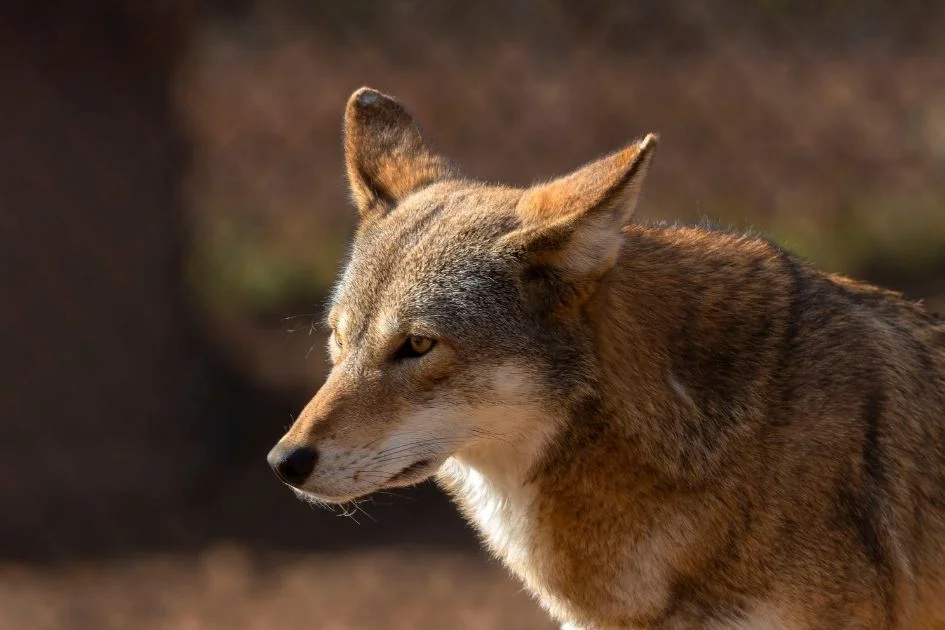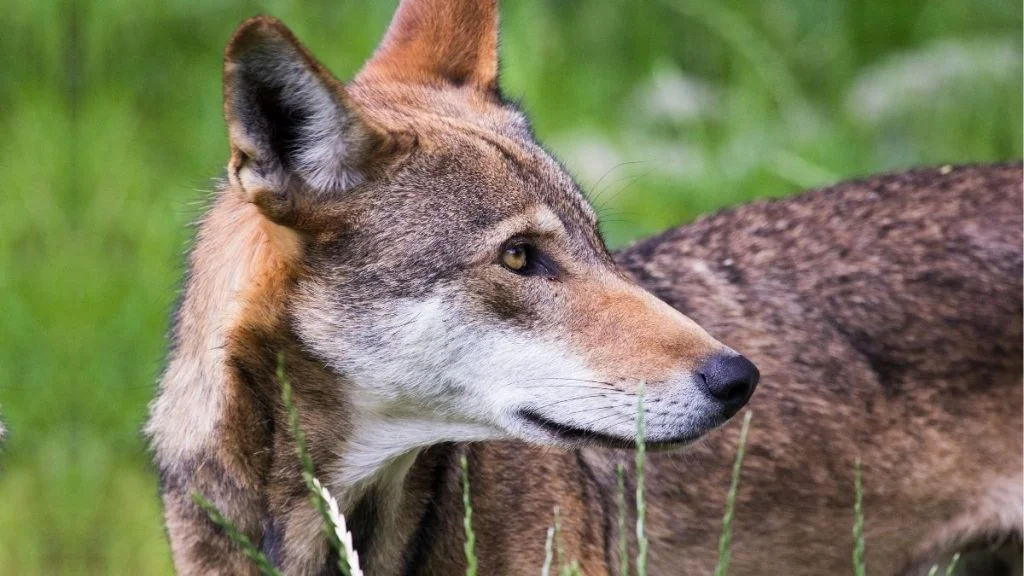The terrain of Alabama is diverse and includes lush plains, rivers, and streams in addition to rugged slopes.
Woodlands, forests, ponds, meadows, and prairies are just a few more than sixty different natural ecosystems to which Alabama is home.
In terms of biodiversity, it comes in fifth place and is top among the regions east of the Mississippi.
Alabama is home to more than 6,000 animal species and this includes the wolf. But at this time, are there wolves in Alabama wildlife?
The red wolf is the only wolf species found in Alabama. However, humans hunted them to extinction during the nineteenth century.
Some factors that led to their extinction were hunting, poisoning, trapping, habitat destruction, and mating with coyotes.
They are listed as endangered by the federal and state governments. Red wolves are currently bred in captivity, and their numbers have gradually increased in recent years.
Read on to find out more about wolves in this southeastern U.S. state.
Are there Wolves in Alabama Wildlife?

No, there aren’t any wolves at the moment in Alabama. Red wolves once frequented the area, but they are now extinct.
Any wolves birthed in Alabama will need to be freed from captivity to make room for their reestablishment into the wild.
This is because wolves are believed to have been eliminated in Alabama since the 1930s.
Seeing as this state does not have a natural wolf population, any wolves born there must be released from captivity.
Although wolves are not native to North America, they were previously widespread in the eastern United States, particularly in the Northeastern and the Great Lakes region.
By the turn of the 20th century, humans had hunted them almost to extermination.
Still, when the government implemented restrictions to preserve both their territory, their population began to grow again.
Although wolves are no longer present in Alabama, they are present in states like Alaska and Washington. Recently, there have been unsuccessful attempts to restore red wolves to Alabama.
More Information on The Red Wolf

Scientific Name: Canis rufus
Situation: Red wolves once occupied a range of environments around the state. In Alabama, it was said to be on the edge of extinction in 1921.
Appearance – What Does a Red Wolf Look Like?
A red wolf’s length is between 3 to 4 feet, and its weight ranges between 40 to 90 pounds. Compared to the more typical coyote, it is much bigger and stronger.
Along the sides, the hair is a rough tawny-cinnamon color with gray and black mixed in.
Along the back, there is a clear transition to a darker gray & black. The wolf has longer legs, bigger feet, and wider ears than a coyote.
The chest and nose are generally white, and the tail is thick with a black point. Tawny features include the legs, nose, ears, neck, and exteriors.
Distribution
Native to the southeastern U.S. state, The red wolf roamed from southern Illinois to Illinois, from the Gulf coast to middle Missouri, and from the Atlantic to central Texas.
The last population was observed in the late 1970s in southeastern Texas and southwestern Louisiana, despite being extinct from the southeastern United States.
There were no recognized wild communities by the 1980s besides the Alligator River National Wildlife Refuge in North Carolina rehabilitation.
All current red wolf populations are housed in captivity. In the early 1920s, the red wolf vanished from Alabama.
Habitat
These animals prefers semi-deciduous river forests and wetlands at different phases of development but will also use farmland and coastal grassland marshes.
Generally speaking, they can flourish in most places with sufficient prey species and very little human interference.
Diet
Tiny groups of roamers hunted small to medium-sized wild creatures. They frequently consumed tiny domestic animals like calves, goats, pigs, and other small farm animals.
Ecology
Red wolves have a sophisticated social structure and live in groups. A permanently mated, territorial partner serves as the leader of packs, which are family units.
Studies show that breeding starts in February and March with a gestation period of 61 to 63 days. The mother will deliver one to eleven pups in April and May, which are weaned after eight to ten weeks. At 22 to 46 months, pups enter adulthood.
Every year, the female will deliver one litter. Each litter is delivered in a den, which may be found in the hollow trunks of trees, along stream banks, on sand knolls, or behind a rocky protrusion. Males and females both contribute to child-rearing.
Although they are generally nocturnal animals, they may travel during the day throughout the winter. A pack’s home territory can be between 10 and 100 square miles.
Pale-skinned deer, squirrels, possums, rabbits, smaller animals, birds, and livestock are some examples of the sources of food.
In the wild, the average lifespan is between 4 to 13 years. However, in captive, they can live up to 16 years.
Poaching, poisoning, and entrapment were used in elimination operations due to perceived risks to people and cattle.
In addition to ecological erosion, struggle with coyotes, and interbreeding, other causes contributed to the red wolf’s fall.
Are There Red Wolves in the Wild?
Eight additional red wolves have joined the country’s only wildlife.
The release of four adult red wolves and four pups bred in captivity into a wildlife preserve in eastern North Carolina has sparked optimism that humans can save this rare species from extinction a second time.
Only found in North Carolina, red wolves are a dying species. Their habitat combines multiple nature reserves and a mishmash of federal, state, and private lands.
Red wolf populations, formerly widespread across the south, central, and east of the United States, drastically declined in the 1900s.
In 1967, they were listed as being “threatened with annihilation.” There are currently only 17 wolves in the wild throughout North Carolina.
How Were Red Wolves Kept From Going Extinct?
Biologists had to take a somewhat perplexing action to save red wolves from an almost certain eradication; they had to extract all remaining red wolves from the wild.
About 400 animals biologists believed to be red wolves were caught in Texas and Louisiana. Their next task was to distinguish between creatures that were coyote/wolf hybrids and creatures that were red wolves.
Only 17 of the initial 400 animals were red wolves, which was a startling discovery. Of the entire species, that was all that remained.
They couldn’t find any other red wolves in the wild, leading them to believe that they’d been mating with coyotes for a very long time. Three of the actual red wolves could not procreate, leaving them with just 14 wolves to deal with.
The rest of them have been placed in a community at the Point Defiance Zoo and Aquarium in Tacoma, Washington, as part of conservation efforts.
They conducted a few “trial” deployments of wolves in South Carolina at the time to fine-tune their plan before attempting to return them to the wild for the first time.
Where Can You Find Wolves?
Wolves can presently be spotted in habitats that extend from Alaska to India. Wolves and their prey have evolved to survive in various environments, encompassing arctic, desert, prairies, and tropical rainforests.
What Puts Wolves in Danger of Being Extinct?
The vast bulk of the planet’s northern hemisphere was once home to wolves. Wolves are currently endangered due to the following reasons:
- Loss of native habitats, which affects the availability of food sources and how they can get them.
- Government initiatives to eradicate wolves during the 20th century.
- Wolves are perceived as a threat to people due to frequent attacks on ranches and farms.
- Incomplete scientific information, leading to misinformation and fear surrounding wolves.
Other Animals in Alabama Wildlife (Mammals)
Sixty-two native mammal species can be found in Alabama, including an ungulate, opossum, armadillo, 11 flesh-eating species, 16 different types of bats, four species of rabbit, 22 rodent varieties, and six insect eaters.
Six other alien (non-native) species, including the whitetail deer, black rat, house mouse, nutria, Norway rat and wild boar, have been adopted in Alabama.
Three carnivore species are classified as accidentals, indicating that a sighting was confirmed but was well beyond the animal’s typical range and that it is unlikely to be seen again.
The red wolf, puma, elk, and bison are four extra creatures that once lived in Alabama but are now extinct (they still exist in other states but no longer exist in Alabama).
Wrap Up
Wolves were once widespread across most of the United States, but they were nearly exterminated by hunting and trapping. In recent decades, however, their numbers have been slowly rising again.
Alabama had wolves once, but they became almost extinct, thanks to early settlers.
To replenish their numbers, the red wolf had to be secured and bred in captivity. There are currently no wolves in Alabama wildlife, but there might be in the nearest future.
Are there wolves in:
Featured Image Credit: SonyaLang / Getty Images






